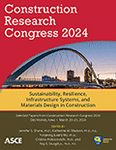Prioritizing Capacity Building Strategies to Ensure Robustness and Faster Recovery of Cellular Networks from Hurricanes
Publication: Construction Research Congress 2024
ABSTRACT
This paper presents a regression-based approach for identifying the impact of county-level capacity building strategies on post-hurricane recovery pattern of cellular networks considering the impact of infrastructure interdependencies. The proposed approach models the recovery rate of the cellular network in a county, based on hurricane damage to cellular network, electricity grid, recovery of electricity grid, and the Baseline Resilience Index for Communities (BRIC). To demonstrate the applicability of the proposed approach, the recovery rate of the cellular network after Hurricane Ida was regressed on the set of predictors using a Tweedie regression. Historical data on the damage and recovery of the cellular network after Hurricane Ida was collected from the US Federal Communications Commission’s reports. The recovery rate of the cellular network and the grid was calculated by fitting an exponential distribution to their recovery curves. The regression coefficients indicate statistically significant relationships between the recovery rate of the cellular network and the level of damage of the cellular network and grid, recovery rate of grid, and BRIC index. The coefficients could be used to estimate the effect of the capacity building strategies to maximize the rate of recovery of the hurricane-damaged cellular network.
Get full access to this article
View all available purchase options and get full access to this chapter.
REFERENCES
Berg, S., E. Unsal, and H. Dijk. 2021. “Non-uniqueness and uncertainty quantification of relative permeability measurements by inverse modelling.” Comput. Geotech. 132, 103964.
Bhattacharyya, A., M. Morshedi, and M. Hastak. 2023. “A clustering-classification approach in categorizing vulnerability of roads and bridges using public assistance big data.” Int. J. Disaster Risk Reduct. 84, 103448.
Bhattacharyya, A., S. Yoon, and M. Hastak. 2021. “Economic impact assessment of severe weather–induced power outages in the US.” J. Infrastruct. Syst. 27 (4), 04021038.
Bruneau, M., S. E. Chang, R. T. Eguchi, G. C. Lee, T. D. O’Rourke, A. M. Reinhorn, M. Shinozuka, K. Tierney, W. A. Wallace, and D. Von Winterfeldt. 2003. “A framework to quantitatively assess and enhance the seismic resilience of communities.” Earthquake spectra. 19 (4), 733–752.
Choi, J., N. Naderpajouh, D. J. Yu, and M. Hastak. 2019. “Capacity building for an infrastructure system in case of disaster using the system’s associated social and technical components.” J. Manage. Eng. 35 (4), 04019013.
Cutter, S. L., C. G. Burton, and C. T. Emrich. 2010. “Disaster resilience indicators for benchmarking baseline conditions.” J. Homel. Secur. Emerg. Manag. 7 (1).
Deshmukh, A., E. H. Oh, and M. Hastak. 2011. “Impact of flood damaged critical infrastructure on communities and industries.” Built Environ. Project Asset Manage. 1 (2), 156–175.
Fisher, R., and M. Norman. 2010. “Developing measurement indices to enhance protection and resilience of critical infrastructure and key resources.” J Bus Contin Emer Plan. 4 (3), 191–206.
He, X., and E. J. Cha. 2018. “Modeling the damage and recovery of interdependent critical infrastructure systems from natural hazards.” Reliab. Eng. Syst. Saf. 177, 162–175.
Kershaw, J., J. Miller, J. Nash, and T. Relkoff. 2000. Vulnerability of the cellular telecommunication network in the lower mainland British Columbia.
Kwasinski, A., W. W. Weaver, P. L. Chapman, and P. T. Krein. 2009. “Telecommunications power plant damage assessment for hurricane katrina–site survey and follow-up results.” IEEE Sys. J. 3 (3), 277–287.
Levenberg, K. 1944. “A method for the solution of certain non-linear problems in least squares.” Q. Appl. Math. 2 (2), 164–168.
Marquardt, D. W. 1963. “An algorithm for least-squares estimation of nonlinear parameters.” SIAM J. Appl. Math. 11 (2), 431–441.
Morshedi, M. A., and H. Kashani. 2020. “A system dynamics model to evaluate the housing market response to vulnerability reduction promotion policies.” Int. J. Disaster Risk Reduct. 44, 101438.
Morshedi, M. A., and H. Kashani. 2022. “Assessment of vulnerability reduction policies: Integration of economic and cognitive models of decision-making.” Reliab. Eng. Syst. Saf. 217, 108057.
Mukherjee, S., R. Nateghi, and M. Hastak. 2018. “A multi-hazard approach to assess severe weather-induced major power outage risks in the us.” Reliab. Eng. Syst. Saf. 175, 283–305.
Oh, E. H., A. Deshmukh, and M. Hastak. 2010. “Disaster impact analysis based on inter‐relationship of critical infrastructure and associated industries: A winter flood disaster event.” Int. J. Disaster Resilience Built Environ.
Oh, E. H., A. Deshmukh, and M. Hastak. 2013. “Criticality assessment of lifeline infrastructure for enhancing disaster response.” Nat. Hazard. Rev. 14 (2), 98–107.
Rowan, E., C. Snow, A. Choate, B. Rodehorst, S. Asam, R. Hyman, R. Kafalenos, and A. Gye. 2014. “Indicator approach for assessing climate change vulnerability in transportation infrastructure.” Transp. Res. Rec. 2459 (1), 18–28.
Scherzer, S., P. Lujala, and J. K. Rød. 2019. “A community resilience index for Norway: an adaptation of the baseline resilience indicators for communities (bric).” Int. J. Disaster Risk Reduct. 36, 101107.
Wang, S., L. Hong, and X. Chen. 2012. “Vulnerability analysis of interdependent infrastructure systems: A methodological framework.” Physica A. 391 (11), 3323–3335.
Tweedie, M. C. K. 1984. “An index which distinguishes between some important exponential families. In Statistics: Applications and New Directions.” In Proceedings of the Indian Statistical Institute Golden Jubilee International Conference. (Eds. J. K. Ghosh and J. Roy), pp. 579–604. Calcutta: Indian Statistical Institute.
Fontaine, S., Y. Yang, W. Qian, Y. Gu, and B. Fan. 2020. A unified approach to sparse Tweedie modeling of multisource insurance claim data. Technometrics. 62 (3), 339–356.
Lee, L. 2021. “Hurricane Ida recovery is slow for Louisiana bayou communities – and nonprofits need your help.” CNN. Accessed April 25, 2023. https://www.cnn.com/2021/12/01/us/hurricane-ida-habitat-recovery-iyw-trnd/index.html.
Information & Authors
Information
Published In
History
Published online: Mar 18, 2024
Authors
Metrics & Citations
Metrics
Citations
Download citation
If you have the appropriate software installed, you can download article citation data to the citation manager of your choice. Simply select your manager software from the list below and click Download.
